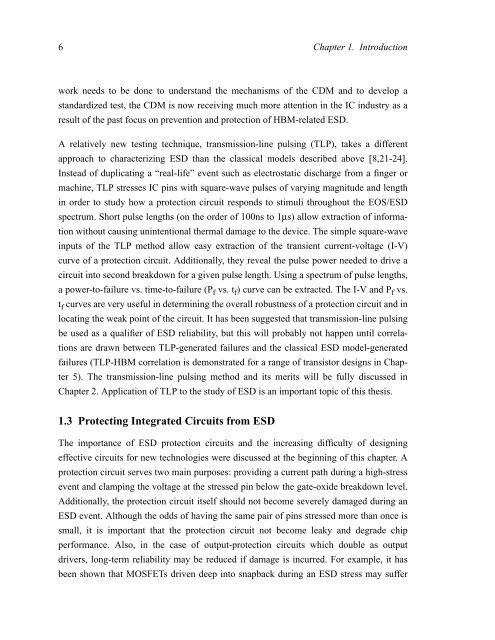characterization, modeling, and design of esd protection circuits
characterization, modeling, and design of esd protection circuits
characterization, modeling, and design of esd protection circuits
Create successful ePaper yourself
Turn your PDF publications into a flip-book with our unique Google optimized e-Paper software.
6 Chapter 1. Introduction<br />
work needs to be done to underst<strong>and</strong> the mechanisms <strong>of</strong> the CDM <strong>and</strong> to develop a<br />
st<strong>and</strong>ardized test, the CDM is now receiving much more attention in the IC industry as a<br />
result <strong>of</strong> the past focus on prevention <strong>and</strong> <strong>protection</strong> <strong>of</strong> HBM-related ESD.<br />
A relatively new testing technique, transmission-line pulsing (TLP), takes a different<br />
approach to characterizing ESD than the classical models described above [8,21-24].<br />
Instead <strong>of</strong> duplicating a “real-life” event such as electrostatic discharge from a finger or<br />
machine, TLP stresses IC pins with square-wave pulses <strong>of</strong> varying magnitude <strong>and</strong> length<br />
in order to study how a <strong>protection</strong> circuit responds to stimuli throughout the EOS/ESD<br />
spectrum. Short pulse lengths (on the order <strong>of</strong> 100ns to 1µs) allow extraction <strong>of</strong> information<br />
without causing unintentional thermal damage to the device. The simple square-wave<br />
inputs <strong>of</strong> the TLP method allow easy extraction <strong>of</strong> the transient current-voltage (I-V)<br />
curve <strong>of</strong> a <strong>protection</strong> circuit. Additionally, they reveal the pulse power needed to drive a<br />
circuit into second breakdown for a given pulse length. Using a spectrum <strong>of</strong> pulse lengths,<br />
a power-to-failure vs. time-to-failure (Pf vs. tf ) curve can be extracted. The I-V <strong>and</strong> Pf vs.<br />
tf curves are very useful in determining the overall robustness <strong>of</strong> a <strong>protection</strong> circuit <strong>and</strong> in<br />
locating the weak point <strong>of</strong> the circuit. It has been suggested that transmission-line pulsing<br />
be used as a qualifier <strong>of</strong> ESD reliability, but this will probably not happen until correlations<br />
are drawn between TLP-generated failures <strong>and</strong> the classical ESD model-generated<br />
failures (TLP-HBM correlation is demonstrated for a range <strong>of</strong> transistor <strong>design</strong>s in Chapter<br />
5). The transmission-line pulsing method <strong>and</strong> its merits will be fully discussed in<br />
Chapter 2. Application <strong>of</strong> TLP to the study <strong>of</strong> ESD is an important topic <strong>of</strong> this thesis.<br />
1.3 Protecting Integrated Circuits from ESD<br />
The importance <strong>of</strong> ESD <strong>protection</strong> <strong>circuits</strong> <strong>and</strong> the increasing difficulty <strong>of</strong> <strong>design</strong>ing<br />
effective <strong>circuits</strong> for new technologies were discussed at the beginning <strong>of</strong> this chapter. A<br />
<strong>protection</strong> circuit serves two main purposes: providing a current path during a high-stress<br />
event <strong>and</strong> clamping the voltage at the stressed pin below the gate-oxide breakdown level.<br />
Additionally, the <strong>protection</strong> circuit itself should not become severely damaged during an<br />
ESD event. Although the odds <strong>of</strong> having the same pair <strong>of</strong> pins stressed more than once is<br />
small, it is important that the <strong>protection</strong> circuit not become leaky <strong>and</strong> degrade chip<br />
performance. Also, in the case <strong>of</strong> output-<strong>protection</strong> <strong>circuits</strong> which double as output<br />
drivers, long-term reliability may be reduced if damage is incurred. For example, it has<br />
been shown that MOSFETs driven deep into snapback during an ESD stress may suffer
















